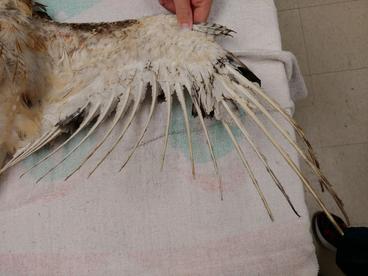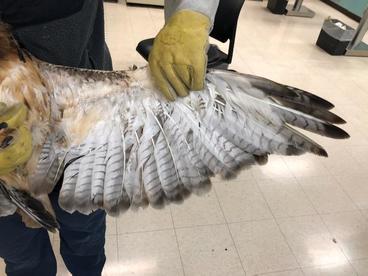“Light as a feather” is a phrase often used to describe something light and insubstantial. Feathers may be lightweight, but they’re anything but insubstantial. They have an amazing microstructure that gives them varying amounts of strength for the different functions they serve.
The functions depend on where the feathers are located on a bird’s body. For example, the large contour flight feathers in the wings and tail have the most complex microstructure and give a bird lift, forward thrust, and drag during flight. Without these feathers, a bird simply could not fly. Although they are strong, flight feathers are still vulnerable to damage. They can be tipped, broken, split, chewed on by parasites, and even burned as one red-tailed hawk (RTHA) discovered last year.
On Sept. 1, 2020, adult RTHA 20-619 was admitted with all of its flight feathers and some of its body feathers singed after flying over a gas flare at a landfill in Buffalo, Minn. The bird was left with bare shafts, like sticks, but fortunately did not sustain any burns to its skin. With so many feathers damaged, this hawk was going to have to molt, a process that naturally would not start until April and run through the summer.

On Sept. 1, 2020, adult RTHA 20-619 was admitted with all of its flight feathers and some of its body feathers singed after flying over a gas flare at a landfill in Buffalo, Minn. The bird was left with bare shafts, like sticks, but fortunately did not sustain any burns to its skin. With so many feathers damaged, this hawk was going to have to molt, a process that naturally would not start until April and run through the summer.

To try to induce the molt to start earlier, clinic staff increased the amount of light the bird received and adjusted its weight. It worked! The bird replaced many of its damaged feathers. But not all were replaced and it still had significant gaps in its wings and tail. This is where feather imping came in. Feather imping is the process of gluing replacement feathers to existing shafts (think hair extensions in humans); there were too many feathers damaged to do this originally but was something TRC staff could do once most had naturally molted.
Seven months later, the hawk started its reconditioning program. As luck would have it, soon after beginning this program, the bird started its natural molt and had to be removed from the program to protect its growing feathers. Finally, in late July, this hawk was able to return to the outside “gym” to rebuild flight muscles and increase its endurance. It was ready to soar once again in the late summer sky, nearly one year after its surprise encounter with the flame.
In 2020, the clinic admitted two other birds, one American kestrel and one peregrine falcon suffering from the same type of feather damage. After following a similar rehabilitation path, they too have been released.